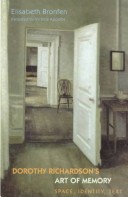Dorothy Richardson's novel cycle "Pilgrimage", completed in 1938, continues to be marginalized despite the fact that in the 1990s several monographs and many articles addressing the issues of gender, genre and modernism have been published. Her work has been recuperated from oblivion primarily as a voice of feminine modernism, but the philosophical underpinnings are still overlooked. Mapping this early modernist text against our postmodern interest in real and imagnined geographies, Bronfen addresses the question of how identity is formed as a result of corporeal and cultural positioning. This book is divided into three parts, each concerned with one aspect of subject formation and location. The first part explores concrete spaces and how these are psychically encoded and how they produce a sequence of sites that ultimately allow the protagonist, Miriam, to construct a coherent story about her own development as a writer. The second part analyzes Richardson's use of spatial metaphor: where boundaries between herself and communities she would like to belong to, but ultimately rejects, are repeatedly drawn.
Bronfen also explores Richardson's key narrative tehniques of the use of spatial tropes involving creativity, textualization, communication and sexuality. In the final part, "Pilgrimage" itself is presented as a textual space, a narrative tapestry where the juxtaposition of event is given preference over narrative temporal sequence.
- ISBN10 0719048087
- ISBN13 9780719048081
- Publish Date 13 May 1999
- Publish Status Out of Print
- Out of Print 19 December 2005
- Publish Country GB
- Imprint Manchester University Press
- Format Hardcover
- Pages 272
- Language English
